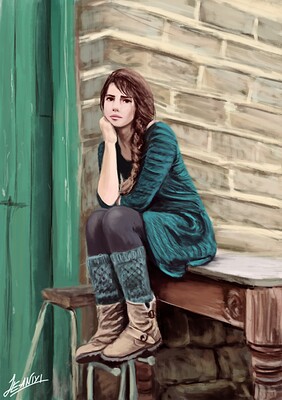Artwork I created with Krita. Just wanted to share it. I’m trying to find the brush I can use to shade, but end up using the same textured brush all the time for my whole working process, and it always looks like this. Don’t know really how people shade their artwork to make it look clean.
Still I hope you like it!
Wow, it’s a beautiful portrait! I really like how the model posed for it.
For the brushes I recommend checking this video. I’m using this brush bundle and have a few favorites there. The video explains how to use each brush and it may give you some new ideas.
Also regarding the clean effect. I think it’s just a matter of sufficient detail. If you keep refining on top of what you have, it will gradually crystallize. However it’s not always required! You can experiment with a more opaque brush too (less blended areas). It may turn out sharper. There’s a good exercise for it, sketching still life with only flat colors to approximate gradients. It helps understand the form and which shadow/light shapes are most important.
I like the painterly look the textured brush gives. Really nice portrait and composition. ![]()
So nicely done! I like the shading.
Thank you for the tip. I know about David and his brushes, he is so good, I do like his work and he knows already what he is doing. I have them but still I find it difficult to understand when to use them. I’m a starting artist and there are just things I can’t find a solution to, but I’d love to ask them from professional artists. I don’t know if comments are a good place to do it. Also I’m having kind of a struggle with the brushes, I could try refine it more and more, but it ends up really blurry in the end mostly, I spend just much more time but the result is not what I thought. I believe my whole process is wrong, I draw mostly on one layer without any blending modes or brushes, only at the end I can add a color filter sometimes. I’ll watch the video again, maybe it’ll really give me some new insights.
Currently just found a basic head painting without any details and just searching for a good brush to copy the shading like in the reference. Simplify it the most I can and try to find what works.
You can do almost all your work on one layer. It keeps things simple. You can make any corrections on a separate layer then if you like the changes, merge that down.
An excellent artist who is among my favorites told me:
Look for reflected light.
Look for the half tones.
There are 3 types of edges: lost, hard, and soft
Cast shadow usually has a hard edge, form shadow usually softer edge.
Remember:
Put the right color in the right shape, in the right spot.
So, when your work gets all 100% blurry looking, then you’ve blended/blurred too much and have lost your hard edges.
Agreed with @CrazyCatBird , I particularly like the workflow of either a) lasso or b) a temporary layer that I then erase parts of and merge down. I normally start using separate layers with alpha lock when the shape is difficult to paint precisely and it must be distinct from the other shapes near it. Like a silhouette of the character.
I don’t do that many paintings, and I’m pretty much a beginner too, but I would recommend doing studies with a focus on a parts that you want to get better at. If you see a nice detail in the reference, try to figure out how to get that effect.
Sorry for plugging my stuff here ![]() but here’s one study I did that I’m particularly happy with. I got a very nice sharp effect in a few places, like the bricks and the street pavement with a simple, hard edge and slightly contrasting lines. I used a slightly textured and not fully opaque brush, as that helped make the line a bit varied in intensity. My point is, just a bit of local contrast helps make things look sharp without that much effort! And I think the secret is to be very selective, if everything is sharp, then there’s not enough variety again.
but here’s one study I did that I’m particularly happy with. I got a very nice sharp effect in a few places, like the bricks and the street pavement with a simple, hard edge and slightly contrasting lines. I used a slightly textured and not fully opaque brush, as that helped make the line a bit varied in intensity. My point is, just a bit of local contrast helps make things look sharp without that much effort! And I think the secret is to be very selective, if everything is sharp, then there’s not enough variety again.
I think this came out beautifully.
If you haven’t already taken a look at this topic, maybe you’ll find more ideas how to solve your task here? →
Michelist

